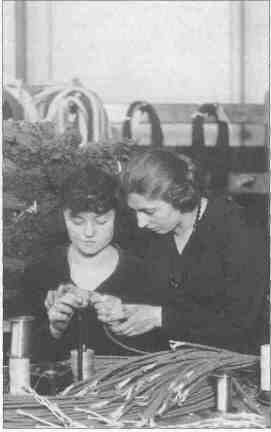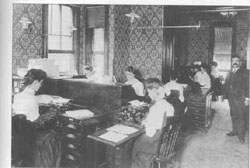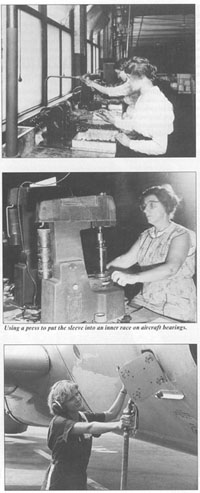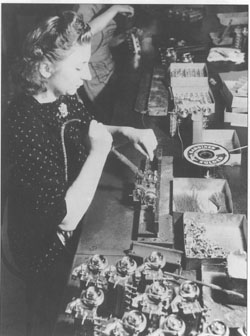Status report
Jennifer Davis, a former Statehouse
bureau chief for Illinois Issues, is a reporter
for the Peoria Journal Star.
IS WELFARE-TO-WORK WORKING?
More people are leaving public assistance. But are they
getting and keeping decent-paying jobs?
And is it government's job to make sure they do?
Analysis by Jennifer Davis
Historic photographs of women at work in Illinois,
courtesy of the Illinois State Historical Library
Wendy's. Burger King.
Lums. Dunkin'
Donuts. NaKisha Davis has
"worked everywhere on
Western Avenue." She's not
bragging. Just frustrated
with her fast-food career on
this busy strip in Peoria. "I
used to work 11 a.m. to 1
p.m.," she says. "That ain't
enough hours." She does
dream, though, about working one day with children.
But there's a drug conviction in her past.
|

On the job, Western Electric Co.
|
Tennille Reed laughs and
mimics the professional
script she used as a telemarketer for AT&T. Then she
remembers her favorite job,
the one she kept for a
month. "You could just listen to your Walkman and
do your work at your own
pace," she says of unpacking
Caterpillar parts for $5,15
an hour. Yet it's unlikely she
could go back because she
quit without notice after the
boyfriend who babysat her
kids went to jail.
These women, both 21,
face some obvious obstacles
to getting anything more
than they've had: low-wage,
low-skilled jobs. Davis can't drive. Reed is a high school
dropout. So they depend on
families and friends to help
them get by. And it hasn't
been easy. Even in this sum-
mer's deadly heat, Davis lives
with one fan because she
doesn't have the extra $10 it
would take to get a second
one fixed.
At the least, both have been
working. But if they slip in
and out of the job market, or
barely make ends meet, who,
really, is responsible? Whose
job is it nowadays to make
sure people like NaKisha
Davis or Tennille Reed get and
keep decent-paying jobs?
Three years after welfare
reform, that's anything but
clear.
In 1996, Congress moved
the nation across a momentous line, ending 60 years of
social welfare policy and
leaving in its place a slogan:
welfare-to-work. The result is
this: Families are no longer
entitled to a basic level of
income support. Instead,
everyone is required to find
work. And nobody will get
financial help from the government for more than a total
of five years. At the same
|
24 September 1999 Illinois Issues
time, the states, which shared
responsibility for welfare programs,
were given a freer hand in deciding
how best to push their poorest citizens
into self-sufficiency. Illinois approved
some reforms in 1996, then retooled
its program in 1997. (See Illinois
Issues, May 1997, page 16, and
July/August 1997, page 6.)
Are the reforms working? By
preliminary accounts, they are.
|

Clerk typists at Abbot Alkaloidal Co. (predecessor to Abbott Laboratories), Ravenswood, 1905. Dr. Wallace C. Abbott is the man at
right. He was the founder of the company.
|
Nationwide, caseloads have
dropped by more than 40 percent. As
of the end of 1998, the most recent
available national statistics, 2.2
million fewer U.S. families were on
welfare. That's 6.5 million fewer
individuals the entire population of
Missouri plus another million or so.
In Illinois, more than 97,000 people
have left the welfare rolls since July 1997.
And more of them are working. The
Welfare-to-Work Partnership conference in Chicago last month was an
opportunity to mark the progress.
President Bill Clinton flew in to congratulate some 12,000 businesses for
hiring 410,000 welfare recipients.
|
"Over the past three years," he said,
"we've proved that if you ask people
|
Women working
Typist. Seamtress. Airplane mechanic.
The photographs of women at work, pages
24-30, come from the Illinois State
Historical Library's collection, "On the
Job in Illinois," a series compiled as part
of the 1976 bicentennial celebration.
The photographs were collected from
factories, utilities and other businesses
and include a wide range of eras.
Where available, we supply the dates
and locations of the images.
|
Illinois Issues September 1999 25
to go to work, they'll go to work."
Indeed, nearly four times more
welfare recipients are working now
than when Clinton took office.
Nationwide, the percentage of Americans on welfare is at its lowest level
since 1967.
Illinois Gov. George Ryan boasted
recently, too. Last summer, five counties Brown, Hardin, Moultrie, Putnam and Schuyler reported that
100 percent of the individuals who
had been receiving assistance were
working. In Chicago, more than 50
percent of those receiving assistance
from seven welfare offices had found
jobs.
Certainly, the economy has helped.
The nation, after all, is enjoying the
longest expansion in history. And
economic experts say a good job
market is encouraging more people to
look for work, many of them welfare
recipients.
"People on welfare are getting a
shot to be in a legitimate economy,"
says state Department of Human
Services Secretary Howard Peters III.
Still, he warns, "the shot may not be
here for long."
In other words, it's likely to get
harder from here. With an eye to a
possible economic downturn, welfare
officials hope to step up their push to
get everyone, especially those facing
multiple barriers, into the labor force.
And because they could need it later,
state politicians are paying close
attention to a proposal by congressional Republicans to redirect $4 billion in federal funds unclaimed by
states due to declining rolls an idea
backed by Illinoisan and U.S. House
Speaker Dennis Hastert.
What's not getting a lot of official
scrutiny are the statistics. There isn't,
critics charge, adequate information
to make a meaningful analysis of the
states' welfare-to-work efforts.
How good are the jobs welfare
recipients are getting? And what
happens if someone leaves the rolls,
walks into a job and walks back out
the next day? Immediately after the
reforms, many states set up studies to
track the progress of welfare-to-work.
Illinois did not.
Chicago Democratic state Sen.
Barack Obama recalls this state's welfare
officials initially balked at the idea.
"They iust didn't want to spend the
money It wasn't a sophisticated
argument. I guess, painting their
decision in the best light, they thought
it would be better to devote money to
actual services."
Peters had another concern. "What
is tracking but taking someone by the
hand and saying, 'I don't trust that
you can find your way.' Why do we
think [people] can't find us again?
They found us the first time when they
needed help. When I hear discussions
on tracking people, it's based on the
assumption that they can't pick themselves up. They aren't children and we
ought not treat them as such."
Still, Dory Rand, a staff attorney
with the National Center on Poverty
Law in Chicago, believes there's a
fundamental reason to assess what's
|
The National Center on Poverty Law tracks immigrants
The number of Illinois' noncitizens who are getting
cash grants under federal and state welfare
reforms has declined faster than it has for U.S.-
born individuals, according to a study released last
month by the National Center on Poverty Law.
The study, compiled by researcher Rob Paral, examined
the number of foreign-born individuals enrolled in every
major welfare program administered by the state. It was
aimed at determining whether trends in immigrant use of
welfare programs have become evident since the 1996
reforms, including limits on eligibility for noncitizens. For
most programs, data was analyzed over a three-year period.
"One result of legislative overhaul," the report concluded,
"has been widespread confusion among immigrants about
their eligibility for benefits programs and fear that they may
be determined to be a public charge."
Among the findings:
Between January 1998 and April 1999, the decline
among noncitizens getting cash grants fell 41.7 percent,
compared to 25 percent among natives.
* The number of foreign-born and natives who are
getting Medicaid health benefits but not Temporary
Assistance to Needy Families grants rose, but not as
much as for naturalized and native citizens. Between
January 1998 and April 1999, use of that program by
noncitizens increased by only 14.7 percent, while use
among naturalized citizens grew by 63.5 percent and use
among natives grew by 45.2 percent.
The percentage of foreign-born adults and children
using food stamps declined faster than for natives. Overall,
the percentage of immigrants getting food stamps fell by
30.4 percent between October 1996 and April 1999,
compared to a decline of 28.5 percent among natives.
In contrast to all other programs, the foreign-born
have increased their numbers in the Aid to the Aged,
Blind and Disabled program, 0.7 percent between April
1996 and April 1999, compared to a decline of 19.9
percent for natives.
These increases, according to the study, may be explained
in part by the heightened attention given to elderly immigrants in the wake of welfare reform, which terminated
eligibility for federal Supplemental Security Income. Subsequent federal legislation restored eligibility to many of these
immigrants, and the state targeted funding to groups helping elderly immigrants naturalize to keep their SSI benefits.
The Editors
|
26 September 1999 Illinois Issues
|

|
happening as people move off welfare.
"If the state is going to claim that their
programs are a success, then I think
they need to show it beyond declining
caseloads," she says. "They need to
show that people are not just leaving
the rolls, but getting out of poverty."
Obama, too, believes raw data on
declining caseloads doesn't tell the
whole story. He successfully sponsored
the only provision mandating tracking
of Illinois' welfare recipients, and that
only passed, he believes, because
universities are footing the bill. "A
large number of people," he says, "are
being pushed into dead-end and low-
income jobs or are being removed from
the rolls because they've violated the
rules we've set up."
Yet Peters has this question: "If
we're not concerned about the jobs
people not on welfare have, then why
are we concerned about the jobs people
on welfare have?"
Meanwhile, the state has released
a study of 150,000 families who left
welfare between July 1997 and June
1998. Most of the research was gleaned
from computerized databases public
health immunization records, public
aid child support enforcement cases,
food stamp records but there were
also in-depth interviews with 1,200
individuals selected at random.
It tells us "the overall picture of life
on welfare is not as attractive as life off
welfare," says Peggie Powers, who
designs and evaluates human services'
programs. "We saw that evictions
declined, utility shut-offs declined."
Further, 79 percent of those interviewed said they were either satisfied or
very satisfied with their jobs. "That's
much higher than we imagined it would
be. We also looked at wages and the
number of hours worked because we
had a foreboding early on that people
might be piecing together two or three
part-time jobs. We found that 87 percent to 90 percent an extremely high
percentage had one job, working
between 36 to 38 hours a week. That
was very good news for us."
Nevertheless, the critical in-depth
analysis just isn't there, argue such
social policy researchers as Paul
Kleppner of Northern Illinois Univer-
|
Illinois Issues September 1999 27
sity in DeKalb. Kleppner, along with
colleagues at Northwestern University
in Evanston and the Metro Chicago
Information Center, undertook to see
what happens after welfare, what kinds
of jobs people are getting, what they're
earning, what additional help they
might need. (See May 1998, page 8.)
|

Production workers assemble push-button auto radio
tuners in Motorola's Augusta Blvd.
facility in Chicago in 1939.
|
The results of an earlier Kleppner
study were grim. In 1995, he found
there weren't enough entry-level
positions for all of the low-skill
workers who would be looking for
jobs. In the long run, he concluded,
Illinois will be hard-pressed to make
welfare-to-work a reality.
Indeed, even if the economy holds
up, it gets harder from here. What
about those who simply don't have the
skills to hold any job, or suffer from
drug abuse? What of those who can't
make work pay enough to take care
of children, or face transportation
barriers? What of those who simply
don't believe in themselves? (See April
1994, page 28.)
Under the welfare-to-work reforms,
is government responsible for addressing these issues?
Obama says, "It's not hard to reduce
the welfare rolls. Just cut people's benefits. Moving people from welfare to
work is much more difficult.'"
"It's just about as tough as we
thought it would be," says the coordinator of Chicago's welfare-to-work
program. Jeff Marcella, who heads
that effort in Mayor Richard Daley's
workforce development office, has
managed to help find jobs for 1,875
welfare recipients who face such
challenges as substance abuse and
domestic violence.
|
NaKisha Davis and Tennille
Reed are not in the hardest-to-employ
group. They have some skills and
experience. They're literate and drugfree. And they've both just completed
a four-week intensive job and life
skills class offered by a private not-
for-profit group working with the
Illinois Department of Human
Services.
Their Peoria class ended shortly
before Clinton landed in Chicago. The
next day, both women landed jobs:
Reed as a telemarketer selling magazines; Davis as an aide in a nursing
home laundry room, where she hopes
to prove herself so she can be included
in a training program to become a
nurse's assistant.
Of the eight who started the class,
these two are the only ones who
finished. One woman left because her
job at a Peoria school cafeteria
became full-time. The others
Robert, a functional illiterate, and
four single mothers just stopped
attending.
Stacy Jackson, their teacher at the
South Side Office of Concern, doesn't
know why. She says when she has
time, she'll try to find out. But every
day, Jackson has to choose between
searching for the five people who
dropped out of her last class and
helping the five new people walking
through her door.
It is, at best, catch-as-catch-can.
28 September 1999 Illinois Issues



